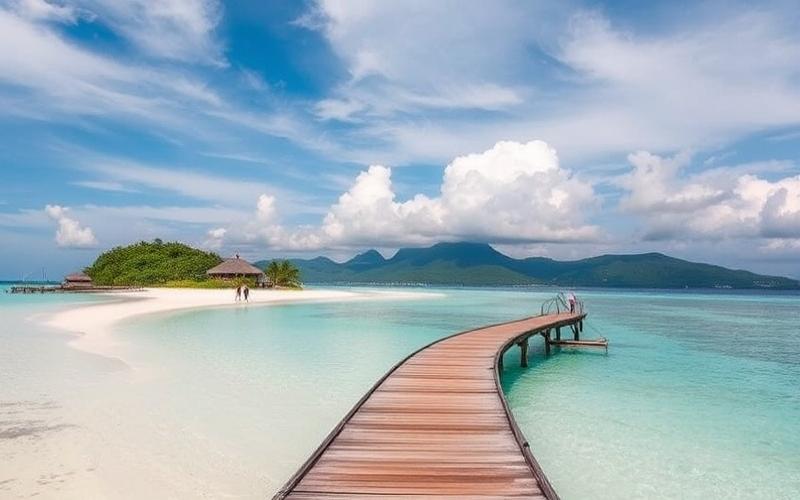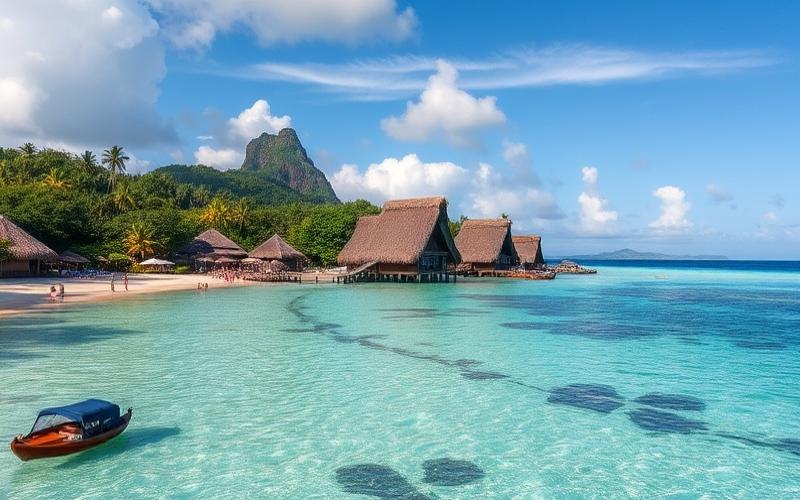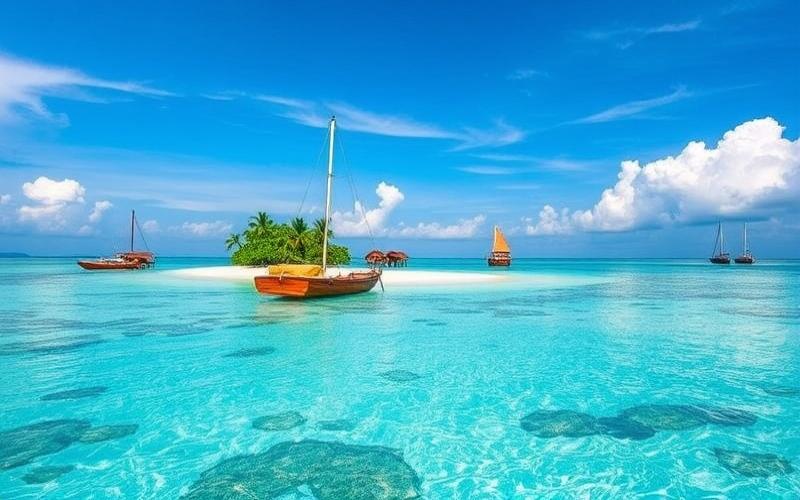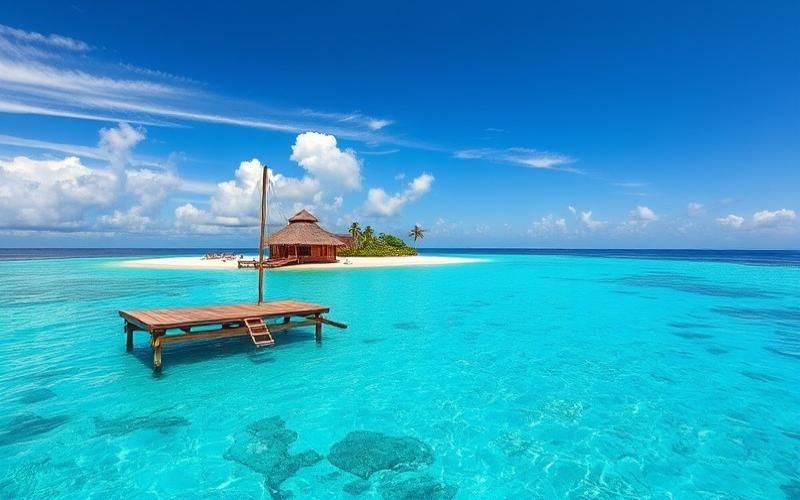
 Published on and written by Cyril Jarnias
Published on and written by Cyril Jarnias
Welcome to Seychelles, this tropical paradise nestled in the heart of the Indian Ocean! If you’re considering relocating to this idyllic archipelago, you probably have many questions about daily life, including public transportation. How can you get around the islands easily and affordably? What transportation options are available? What budget should you allocate for your travels? In this article, we’ll explore Seychelles’ public transportation system in detail, helping you better prepare for your future life as an expatriate in this little corner of paradise.
A Bus Network That Covers the Main Islands
In Seychelles, buses are the most widespread and commonly used form of public transportation, both by locals and expatriates. The bus network mainly covers the three most populated islands: Mahé, Praslin, and La Digue. The network is most developed on Mahé, the main island where the capital Victoria is located.
The Seychelles Public Transport Corporation (SPTC) is the public company that manages the entire bus network across the islands. Buses are recognizable by their blue and white colors and serve most residential and tourist areas. Bus lines typically operate from 5:30 AM to 8:30 PM, with higher frequency during peak hours. Note that service is less frequent on Sundays and public holidays.
One of the major advantages of Seychelles’ bus network is its very affordable cost. A single bus ticket costs only 12 Seychellois rupees (SCR), approximately €0.79[1]. It’s an economical way to get around, particularly appreciated by expatriates looking to manage their transportation budget. Additionally, buses offer an authentic experience and allow you to immerse yourself in local life while enjoying the islands’ magnificent landscapes.
Good to Know:
Buses in Seychelles are air-conditioned and relatively comfortable. However, they can be crowded during peak hours, so it’s advisable to allow some extra time for your travels.
Taxis: A Convenient but More Expensive Option
While the bus network is well-developed in Seychelles, it can sometimes be limited in terms of schedules or destinations served. This is where taxis come into play, offering a convenient and flexible alternative for your travels.
Taxis are easily recognizable by their yellow color and are available in main tourist areas, at the airport, and in Victoria’s city center. They typically operate with a meter, but it’s always better to agree on the fare before getting in, especially for longer trips.
The cost of taxis in Seychelles is significantly higher than buses but remains reasonable compared to rates in many Western countries. The base fare is about 100 SCR (€6.60), and each kilometer costs around 30 SCR (€1.98)[1]. For a trip from Mahé International Airport to Victoria city center, expect to pay about 300 SCR (€20).
It’s important to note that taxi fares can vary depending on the time (night surcharge) and day (higher rates on Sundays and public holidays). Additionally, some drivers may offer package deals for excursions or tourist tours.
Good to Know:
If you plan to use taxis frequently, it might be wise to ask for the phone number of a trusted driver. This will allow you to benefit from more personalized service and potentially preferential rates.
Ferries: Essential for Inter-Island Travel
Since Seychelles is an archipelago, traveling between islands is an integral part of the transportation system. Ferries are the preferred means of transport for getting from one island to another, particularly between the three main islands: Mahé, Praslin, and La Digue.
Two main companies operate these inter-island connections: Cat Cocos and Inter Island Ferry. Cat Cocos provides the connection between Mahé and Praslin with fast catamarans, while Inter Island Ferry offers trips between Praslin and La Digue with traditional ferries.
The journey between Mahé and Praslin takes about one hour, while the trip between Praslin and La Digue only takes about fifteen minutes. Prices vary depending on distance and boat type, but expect to pay between €50 and €70 on average for a one-way trip between Mahé and Praslin.
It’s important to note that ferry schedules can be affected by weather conditions, particularly during the rainy season (October to March). Therefore, it’s recommended to check schedules in advance and allow some buffer time in your travels.
Good to Know:
If you plan to travel frequently between islands, some companies offer loyalty cards or multi-trip packages that can help you save substantially.
Transportation Budget for an Expatriate: How Much to Allocate?
For an expatriate living in Seychelles, the transportation budget can vary considerably depending on lifestyle and travel habits. However, we can provide an estimate based on regular use of public transportation.
For daily bus travel, a monthly pass costs about 360 SCR (€24)[1]. This pass offers unlimited access to the bus network on the island where you reside, making it a very economical option for regular travel.
If you occasionally use taxis, budget for additional expenses. Estimating two to three taxi rides per week, you can add about 1000 SCR (€66) to your monthly budget.
For inter-island travel, if you make one round trip per month between Mahé and Praslin, for example, that would represent a cost of about €140 per month.
In total, a reasonable monthly transportation budget in Seychelles could range between €200 and €300 for an expatriate, depending on the frequency of inter-island travel and taxi use.
It’s important to note that this budget can be significantly reduced if you limit your taxi rides and inter-island trips. By primarily using buses and limiting ferry journeys, you can easily keep your transportation budget below €100 per month.
Good to Know:
Gasoline prices in Seychelles are relatively low compared to many European countries. If you’re considering buying or renting a vehicle, note that a liter of gasoline costs about 21 SCR (€1.36)[1], which could make the option of a personal car attractive for some expatriates.
Practical Tips to Optimize Your Travel
To make the most of Seychelles’ transportation system while managing your budget, here are some practical tips:
- Invest in a monthly bus pass if you regularly use this mode of transport. It’s the most economical option for your daily travels.
- Plan your trips in advance, especially if you depend on bus or ferry schedules. Delays are frequent, so allow for some buffer time.
- For short trips, don’t hesitate to walk. Seychelles offers magnificent landscapes, and many places are accessible on foot.
- If you need to take a taxi, try sharing it with others to reduce costs.
- For inter-island travel, book your ferry tickets in advance, especially during peak tourist season.
Remember that driving is on the left in Seychelles. If you’re considering renting a car or scooter, familiarize yourself with this particularity first.
Finally, consider the environmental impact of your travels. Seychelles is a fragile ecosystem, and prioritizing public transportation or walking helps preserve the archipelago’s natural beauty.
Good to Know:
Many hotels and resorts offer free shuttle services for their guests. If you have visitors, this can be an interesting option to reduce transportation costs.
Challenges and Future Prospects for Transportation in Seychelles
Despite a relatively well-developed public transportation system, Seychelles faces several mobility challenges. Population growth and increasing tourism are putting growing pressure on existing infrastructure.
Traffic jams are becoming increasingly frequent, particularly on Mahé Island, and especially around Victoria during peak hours. This situation affects bus punctuality and increases travel times.
Facing these challenges, the Seychellois government has launched several initiatives to improve and modernize the transportation system. Among the ongoing or planned projects are:
- The introduction of electric buses to reduce the carbon footprint of the public transport network.
- Improving road infrastructure, including widening some roads and creating new lanes to ease traffic flow.
- Developing bicycle lanes to encourage soft mobility options.
- Exploring innovative maritime transport solutions to improve inter-island connections.
These initiatives are part of a broader sustainable development vision, aiming to balance economic growth, environmental preservation, and improved quality of life for residents and visitors.
For expatriates, these developments could translate into improved quality and efficiency of transportation in the coming years. However, it’s also possible that these improvements will be accompanied by increased transportation costs in the medium term.
Good to Know:
Seychelles is committed to sustainable development and encourages the use of electric vehicles. If you’re considering buying a vehicle, electric options benefit from attractive tax incentives.
In conclusion, Seychelles’ transportation system offers a variety of options for getting around, from the economical bus network to more flexible taxis, and the essential ferries for inter-island travel. Although challenges persist, particularly in terms of traffic congestion, the government’s efforts to modernize and improve infrastructure suggest a promising future for mobility in the archipelago.
For an expatriate, adapting to the local transportation system is an integral part of the Seychelles living experience. With a bit of planning and by leveraging the different available options, it’s entirely possible to travel efficiently while managing your budget. Remember that every bus or ferry ride is also an opportunity to discover the islands’ natural beauty and immerse yourself in the local culture.
Disclaimer: The information provided on this website is for informational purposes only and does not constitute financial, legal, or professional advice. We encourage you to consult qualified experts before making any investment, real estate, or expatriation decisions. Although we strive to maintain up-to-date and accurate information, we do not guarantee the completeness, accuracy, or timeliness of the proposed content. As investment and expatriation involve risks, we disclaim any liability for potential losses or damages arising from the use of this site. Your use of this site confirms your acceptance of these terms and your understanding of the associated risks.


























